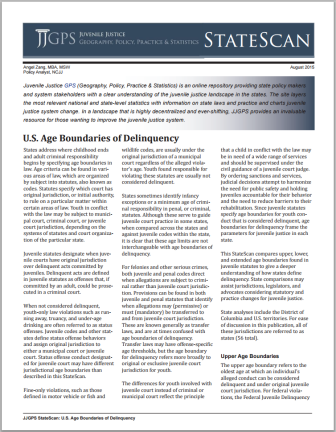The most telling number in a new report on how states decide who is a juvenile and who is an adult in the justice system isn’t necessarily 18 or even 17 or 16.
Instead, consider the number four.
That’s the number of states that have implemented “raise the age” reforms based on the upper age boundary of juvenile jurisdiction since 2009, according to the report from the National Center for Juvenile Justice.
The boundary determines which juveniles who accused of an offense are treated as an adult. In most states, it’s 17, which means young people are juveniles until they turn 18. This is separate from transfer laws that move a juvenile to adult court for felonies or other serious crimes.
Changes in four states may not sound like much, but in the more than three decades before that, only one state, Alabama, raised the upper boundary. (Unless you count Rhode Island, which both lowered and raised its age limit from 17 to 16 and back again in one tumultuous year.)
That cluster of changes since 2009 is important because states historically haven’t done much to the upper age limit, said Melissa Sickmund, director of the center.
“It’s not something that states change all the time. They tend to leave it be,” she said. “The fact that states are changing is huge.”
 The changes mean more young offenders remain in the juvenile system with access to rehabilitative program and treatment. They also avoid the collateral consequences of the adult system when they are released, such as no access to student loans or limits on where they can be employed.
The changes mean more young offenders remain in the juvenile system with access to rehabilitative program and treatment. They also avoid the collateral consequences of the adult system when they are released, such as no access to student loans or limits on where they can be employed.
Only nine states set an upper age boundary of 15 or 16 years old, compared with 17 in all the others. That means a dwindling number of states have yet to enact changes that keep young offenders in the juvenile system until they are 18.
Sickmund said the spate of changes is a development that could signal a shift from asking who’s next to raise the age to who’s going to be last.
“Are we going to get to a place in the not too distant future where every state considers that 18th birthday the borderline? That will be unique in our history,” she said.
Opponents of raise the age policies cite potential costs or say the changes would mean juveniles face punishments that are too lenient for their crimes.
Since 1975, eight states have changed the upper age of juvenile court jurisdiction, according to the report.
Four states have raised the age, two have lowered it and two have done both. Like Rhode Island, New Hampshire lowered the age and then raised it again, though the changes came nearly two decades apart.
Connecticut, Illinois, Massachusetts and New Hampshire are the four states that have implemented upper age boundary changes since 2009.
The report, “U.S. Age Boundaries of Delinquency” by Angel Zang, tracks the age boundaries that determine who is a juvenile in the states, the District of Columbia and five U.S. territories.
Extended age boundaries range from ages 18 to 24, with two states setting no limit. The extended boundaries allow a juvenile court to keep jurisdiction over an individual, often so a judge can monitor his or her progress.
The center is the research division of the National Council of Juvenile and Family Court Judges.


Thanks for covering this release JJIE. There are more of this series distilling JJ-GPS website content on http://www.jjgps.org/publications.
As a parent it is difficult to fathom how in at least one state a 6-year-old, most likely just fresh out of kindergarten, is within the purview of a system designed primarily for teenagers in conflict w/ the law, and a 16-year-old, sophomore entering high school crosses a important line that places them within the original jurisdiction of the criminal justice system for even a minor offense.
In trying to help a state out today considering the lower age boundary, I revisited the issue in the old NAC/OJJDP Standards for the Administration of Juvenile Justice (1980) and realized that over 30 years ago, 10 for lower, 17 for upper and 21 for extended age were pretty much the consensus, even among 3 separate, and at times competing, national JJ standard-setting efforts (p. 260, Standard 3.115). http://babel.hathitrust.org/cgi/pt?id=mdp.39015005266088;view=1up;seq=7
I thought going back to 15-year-old national juv. just. standards that had this kind of reach into specifics and a federal imprimatur was rough back in 1995, and here I’m still having to do it in 2015 on this and many other fundamental juvenile justice administration issues.